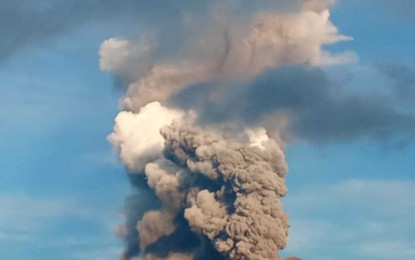Mount Kanlaon, one of the most active volcanoes in the Philippines, erupted today—April 8, 2025—sending a towering ash plume 4 kilometers into the sky. For many residents in Negros Island, it was an early morning wake-up call that shook windows and filled the air with ash and uncertainty.
This blog breaks down everything you need to know about the Mount Kanlaon eruption today—from what happened during the explosion to the alert level, safety warnings, affected areas, travel restrictions, and more. Whether you’re a local, a tourist, or just staying updated, this is your full guide to today’s volcanic activity.
🔥 What Happened: Eruption Timeline and Details
Time of eruption:
- 5:51 AM — A phreatic (steam-driven) explosion occurred without prior warning.
- The explosion lasted approximately 55 seconds and generated a volcanic plume that rose about 5,000 meters (4 km) above the summit.
Type of eruption:
This was a phreatic eruption, caused by the interaction of groundwater and magma. These types are typically sudden and can be extremely dangerous due to flying debris and pyroclastic density currents (PDCs).
Location:
- Mount Kanlaon, located on Negros Island, is the highest point in the Visayas and part of the Pacific Ring of Fire.
⚠️ Current Alert Level: Alert Level 3
As of April 8, 2025, the Philippine Institute of Volcanology and Seismology (PHIVOLCS) has raised Mount Kanlaon to Alert Level 3, meaning:
- Increased volcanic activity is expected.
- Hazardous eruptions are possible within weeks or even days.
- Residents are advised to prepare for more explosions.
PHIVOLCS has warned people to stay at least 6 kilometers away from the Permanent Danger Zone (PDZ) around the volcano.
The Phivolcs bulletin is found at this link https://www.phivolcs.dost.gov.ph/index.php/volcano-hazard/volcano-bulletin2/kanlaon-volcano/30493-bulkang-kanlaon-buod-ng-24-oras-na-pagmamanman-08-abril-2025-alas-12-ng-umaga
🌋 Ashfall and Pyroclastic Density Currents (PDCs)
During the eruption, pyroclastic density currents (hot gas and ash flows) rolled down the southern and southeastern slopes. These are deadly and extremely fast-moving.
Ashfall reports came in from the following towns and cities:
- La Castellana
- Moises Padilla
- Bago City
- San Carlos
- Other parts of Negros Occidental and Negros Oriental
People in the affected areas experienced:
- Reduced visibility
- Breathing difficulties
- Ash-covered crops and rooftops
Local governments have already advised schools to suspend classes and residents to wear masks and stay indoors if possible.
🛫 Travel and Aviation Warning
The Civil Aviation Authority of the Philippines (CAAP) issued a Notice to Airmen (NOTAM) shortly after the eruption.
Why this matters:
- Volcanic ash is extremely hazardous to aircraft, especially jet engines.
- Pilots are advised to avoid flying close to Kanlaon and adjust flight paths as needed.
- Flights to/from Bacolod–Silay Airport and Dumaguete-Sibulan Airport may experience delays or rerouting.
If you’re traveling in the region, check with your airline for the latest updates.
🧭 Location of Mount Kanlaon and Nearby Areas Affected
Mount Kanlaon spans the provinces of Negros Occidental and Negros Oriental. Here are the key cities and towns within the risk zone:
- La Carlota
- Canlaon City
- La Castellana
- Bago City
- San Carlos
- Bacolod
- Dumaguete
If you’re in or near any of these locations, stay updated via local government advisories and PHIVOLCS alerts.
📷 Photos and Videos Flood Social Media
As soon as the eruption began, social media platforms like Twitter, Facebook, and TikTok were filled with dramatic images and videos. Locals captured the massive ash plume rising at dawn, with many comparing the event to Mayon or Taal eruptions.
Trending hashtags as of this morning include:
#KanlaonEruption#KanlaonVolcano#NegrosAshfall#PHVolcanoAlert
This kind of viral spread helps raise awareness quickly, but it’s also important to filter reliable news from rumors or fake alerts.
🌿 Environmental and Agricultural Impact
The eruption’s fallout isn’t just a human concern. The fertile lands around Mount Kanlaon, known for rice, sugarcane, and other crops, are also affected.
Ash can:
- Destroy crops
- Contaminate water supply
- Harm livestock and wild animals
Farmers are being advised to monitor soil and crop health closely in the days following the eruption. Disaster response teams are evaluating the scale of the agricultural damage.
🧑⚕️ Health and Safety Reminders
With the ash cloud drifting across multiple municipalities, respiratory safety is now a top concern. Here’s what to do:
Health tips:
- Wear N95 masks or cover your nose and mouth with a damp cloth.
- Stay indoors with windows and doors closed.
- Avoid physical activity outside until the air clears.
- Clean ash from roofs—but carefully, as wet ash is heavy and can cause structures to collapse.
Local health units are monitoring for increased cases of asthma, cough, and other respiratory illnesses, especially among children and seniors.
🔎 What Makes Mount Kanlaon Dangerous?
Mount Kanlaon is part of the Pacific Ring of Fire—a horseshoe-shaped region with over 450 volcanoes, many of them active.
It’s had multiple eruptions in the past:
- 2006: Minor eruption with ashfall
- 2016: Eruption with steam explosions and ash emissions
- 2020: Minor volcanic activity with seismic swarms
This morning’s eruption is being compared to the 1996 Kanlaon eruption, which tragically claimed the lives of several hikers due to sudden pyroclastic flows.
📢 PHIVOLCS Official Recommendations
PHIVOLCS urges residents, LGUs, and tourists to follow these guidelines:
- Avoid climbing the volcano or entering the 6-km Permanent Danger Zone.
- Monitor official updates via PHIVOLCS’ official website and Facebook page.
- Don’t believe in fake news or unverified alerts.
- Prepare emergency kits with:
- Masks
- Drinking water
- Flashlights
- Battery-powered radios
🗺️ Should You Cancel Travel Plans to Negros?
For now, non-essential travel to areas near Mount Kanlaon is discouraged. If you’re a tourist currently in:
- Bacolod
- Canlaon City
- Dumaguete
…make sure to check with local authorities and your hotel for safety advice. Tour guides and mountaineering trips are all canceled until further notice.
Negros is still open in many parts—but stay updated on road conditions, airport delays, and ashfall advisories.
🧭 What’s Next?
Volcanoes are unpredictable. While PHIVOLCS has not yet forecast another major explosion, the possibility of successive eruptions remains.
What’s being monitored now:
- Volcanic tremors and seismic activity
- Gas emissions
- Crater glow or lava flow
- Further ash emissions or PDCs
The next few days are critical. Scientists and volcanologists are on-site, monitoring 24/7.
Final Thoughts: Stay Calm, Stay Informed
The eruption of Mount Kanlaon today is a reminder of how powerful nature can be. For residents of Negros and nearby provinces, it’s time to stay alert but not panic.
Government agencies are mobilized. Airlines are issuing updates. Schools are closed for safety. And as long as you stay informed and follow official instructions, you’re minimizing your risks.
✅ Summary: Key Takeaways About Today’s Mt. Kanlaon Eruption
| Info | Details |
|---|---|
| Eruption Date | April 8, 2025 |
| Eruption Time | 5:51 AM |
| Type | Phreatic (steam-driven) explosion |
| Ash Plume | Up to 4–5 km high |
| Alert Level | Level 3 |
| Hazards | Ashfall, pyroclastic flows |
| Affected Areas | Negros Occidental & Negros Oriental |
| Recommended Safety Zone | 6 km from crater |


